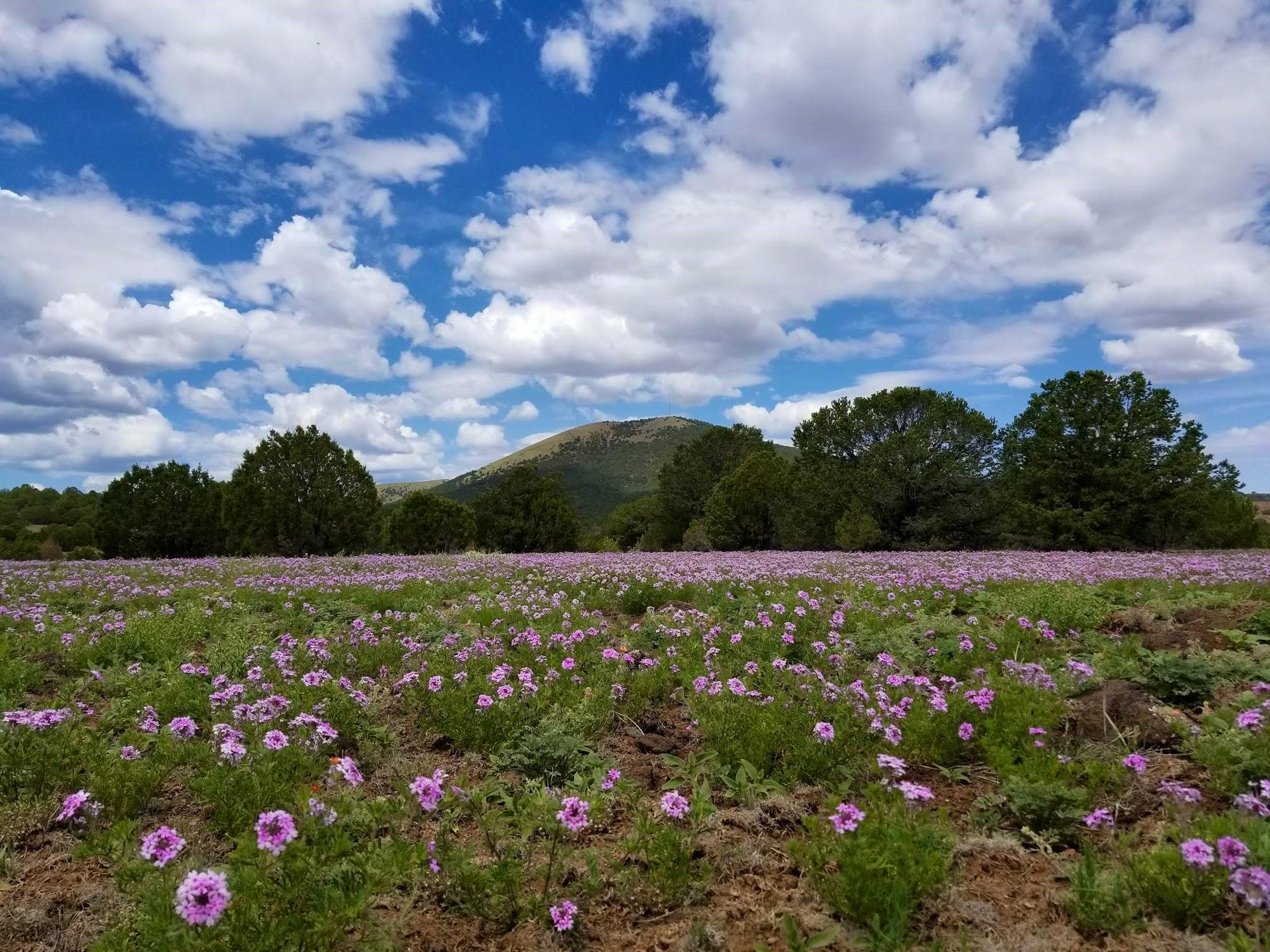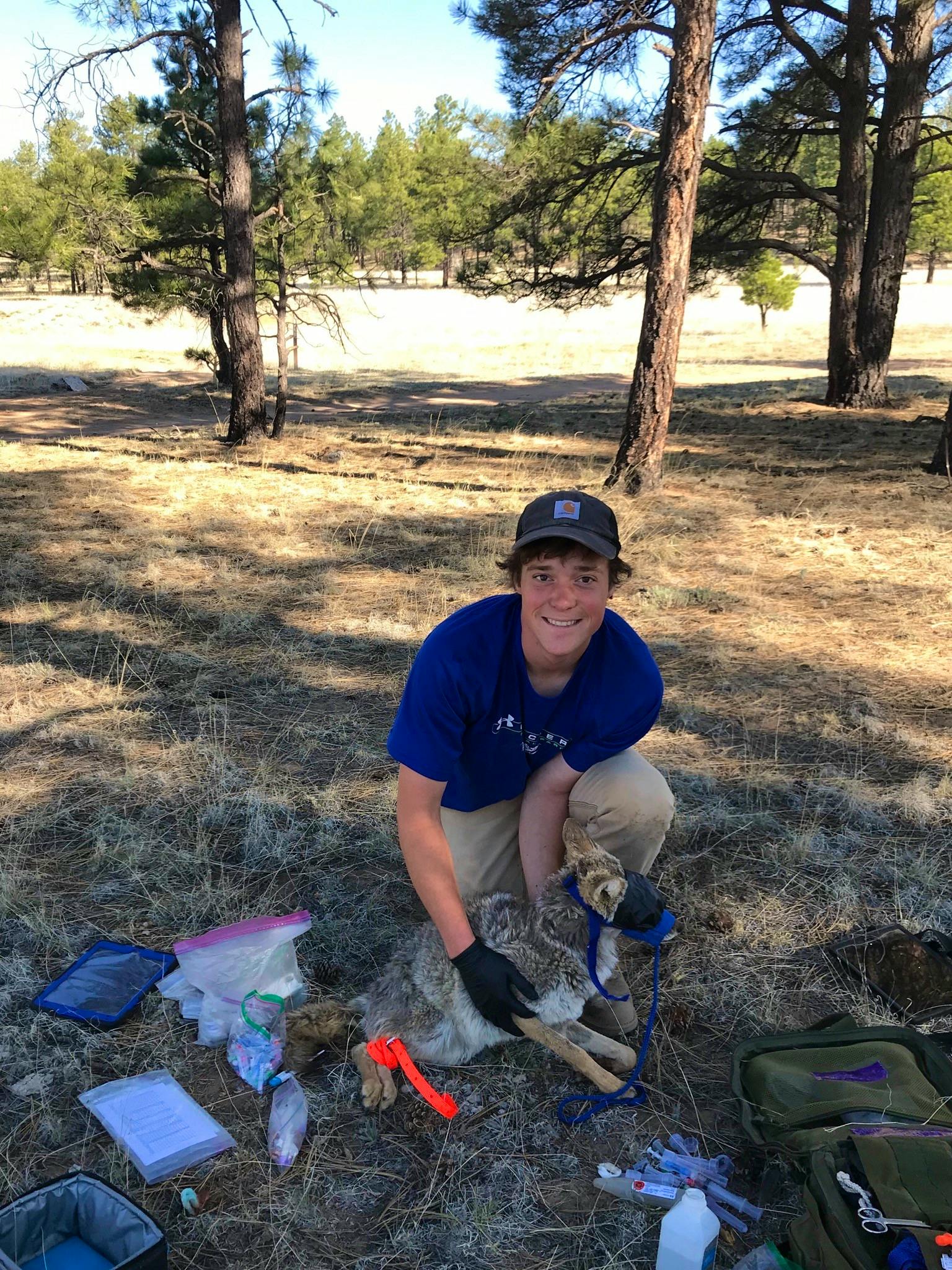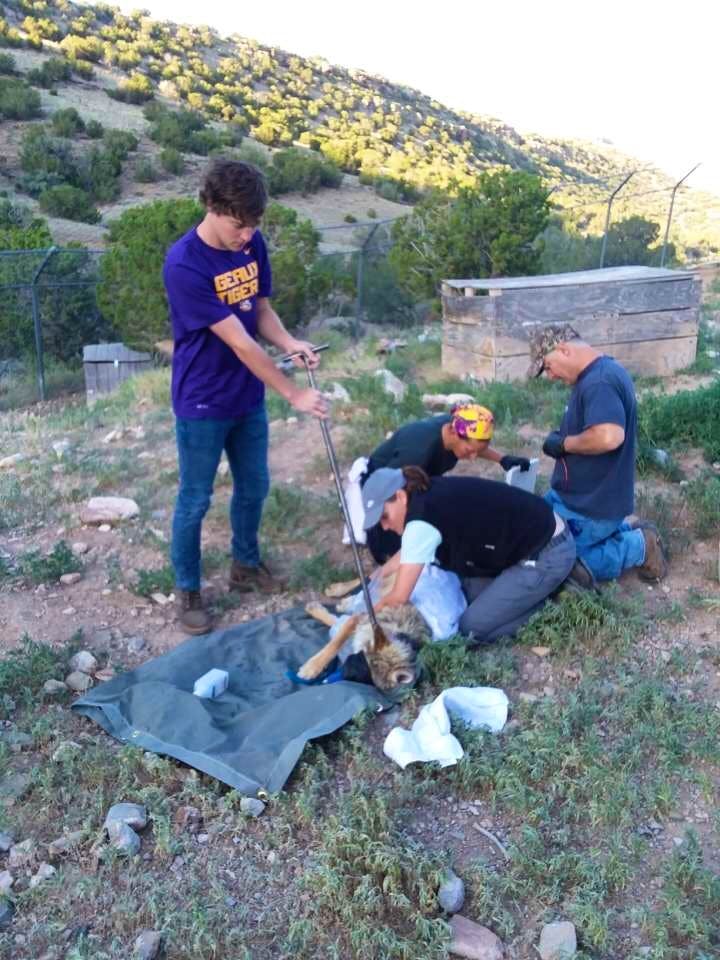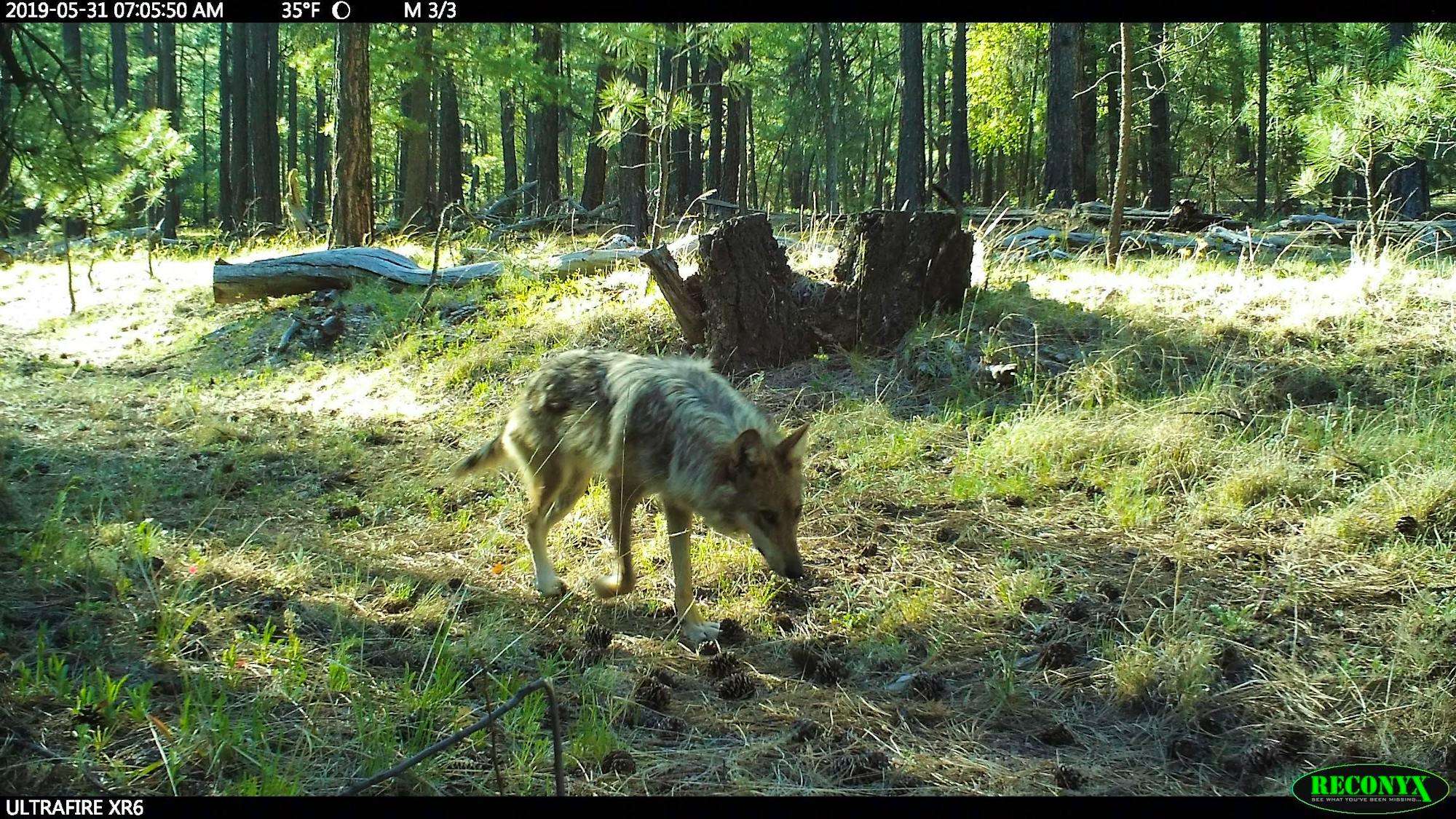We have some amazing interns working on Mexican gray wolf recovery efforts who are instrumental in every step of the process, from field camera monitoring to one of the most successful cross-fostering events! To make this happen, Defenders teamed-up with the California Wolf Center, a captive breeding facility for Mexican gray wolves, to support a field internship program, where volunteers with experience in biology and wildlife management help the U.S. Fish and Wildlife Service and Arizona Game and Fish Department to monitor wolves and implement conflict-reduction tools and techniques to give our lobos the greatest chance of success in the wild. So far, we have supported nine interns in 2019 and about 75% of their time this month was spent on proactive conflict avoidance.


June was in many ways a new beginning. After our first two months getting acclimated to the program, we all found ourselves newbies yet again. The third month began with us rotating our duty station, for me that meant moving from Pinetop where I worked with Arizona Game and Fish, to Alpine where I began working with U.S. Fish and Wildlife Service’s new biologist Ed Davis. Ed had just returned from getting his master’s degree but before that he was a biologist with Arizona and before that he was an intern like myself.
Because this month I was not only working with a new biologist but a new state entirely, I had to learn new packs, roads and food caches. We hit the ground running by keeping the caches stocked and began monitoring wolf locations via radio telemetry.
Later in the month I got the opportunity to try and locate the wolf den of our Luna pack by setting up with a spotting scope across the canyon from the suspected den and observing for hours at a time. After about four hours of little to no action I left the area to set up a trail camera for another one of our packs in hopes we would get pictures and a count of this year’s wolf pups. That night I camped out instead of driving the 3 hours back to Alpine. The next morning, I arose at 5 am and returned to my vantage point in hopes that the wolves would be more active, and I could better locate the den. Again, after spending the next 5 hours looking through a scope, I called it a day and returned to the office.
Gabe Gonzalez


This month, my most exciting tasks have required me to get in the mindset of the wolves we work with. Whether I’m getting a triangulation from the collaRed Wolves, searching for a new spot to put a trail camera, or setting traps for uncollared animals, I need to think “where would I go if I were them?”
I had my first experience of this work style when I set out to put up a new camera for the Colibri pack, who have a den in the wilderness. This den, which we found through GPS signals, was miles from any man-made trail. My path on the map was fairly clear: follow the river valley that leads to the GPS point. But on the ground, I had to navigate a labyrinth of thick trees, boulder fields, steep banks, and fallen logs. So what would a wolf do? Find a game trail! Deer and elk prefer the path of least resistance, and so do their hunters. I slowly made my way up the canyon, following any ungulate tracks that I could. It wasn’t long before I found a wolf’s paw print among the elk tracks. Sometime later I found another, then another. After several hours of slowly navigating, I came upon the perfect site for the trail camera: a small grassy clearing near the stream, just below the den site and complete with three very surprised bull elk! It was satisfying to know that our pack had a solid prey base and a little highway.
With most of our collared packs, such as Colibri, we can get a good sense of who’s there by setting up a camera near their den site. However, as I found out later in the month, the strategy is a little different when the female refuses to settle down. This female wolf - unassociated with any known pack - had been wandering through a wide area for several weeks. Our goal was to find out whether she had an uncollared mate. But since she didn’t appear to have a den site, we had to put the camera on a trail that we thought she used regularly.
First, I drove towards her last GPS location to try and get a live radio signal from her collar. Once I had a ground view of her habitat, I could find the nearest trails and set up a camera near her track way. In theory. The problem occurred when I found her very far away from an accessible trail. I drove toward her most recent GPS point, only to find the road blocked. So I had to get her live signal by getting up high, rather than getting very close. I hiked up the nearest series of peaks to triangulate the wolf’s location, to find that she was deep in a series of bluffs southwest of me. So I had to backtrack. Maybe I could find a better spot among her earlier travels. I drove southbound to a UTV trail near the wolf’s GPS points from a few days prior. Lo and behold! A beautiful set of wolf tracks and a perfect spot for a camera.
This week I’ve been facing my biggest tracking challenge yet: finding uncollaRed Wolves to trap them. Cyrenea and I have been working a trap line to try and capture wolves so that we can take DNA samples, administer vaccines, and collar them for future management. But to trap them, we have to find them. It’s much trickier when we don’t have a GPS point or a radio signal to use as a guideline.
Ben Breslau
June has been another wonderful, experience gaining month. I moved to Pinetop Arizona on the first and have had the chance to make new friends on other projects while living in the bunkhouse. This month my main focus at work has been on stocking food caches and going through trail camera pictures. Arizona Game and Fish is very proactive about using road kill deer and elk as often as they can in order to make food logs last longer. Which has given me the perfect opportunity to become proficient at operating a winch and comfortable quartering the carcasses.
The first time I was sent out to collect an elk from the side of the road I was instructed to take the quarters to one of our freezers, leave the torso on a food cache and then bring back its head in order to be shown how to collect the lymph nodes for Chronic Wasting Disease tests.



Uncollared sign search became a bigger part of my life again towards the end of the month. Aside from a few scattered days by myself spent searching south of route 260, a large effort was spent around the northwest corner of the reservation. I was excited to find a few scat piles and enjoyed the scenery from another part of Arizona. One of the reservation interns rode with me and she and I shared our experiences, recalled favorite movies and gave each other ideas on where to travel and what I definitely need to check out while in the area while we were constantly scanning the roads.
It's surreal how quickly three months can go by when you're doing what you love and are excited for every morning you get to go to work. July here we come!
Megan Huggins
I made the journey to Sevilleta NWR in New Mexico from Alpine, Arizona to start the month. I knew things would be different, but other than that, I didn’t really know what to expect. I spent the first few days unpacking and getting to know the area a little better. Little did I know I would have the most fun and exciting month yet while on the program.
My first assignment involved camping in the National Forest near Winston, Arizona. There I located 1827 of the Whitewater Canyon Pack and checked trail cameras. The camera placed in Stiver Canyon, in between Burnt Cabin Flat and the USFS 74 Draw road, had photos of the uncollared Burnt Cabin pack from May 31st. The trail camera I put up on June 12th in 74 Draw took photos of a bobcat, elk, gray fox, and deer.




On June 14th I helped with a wolf capture at the Sevilleta captive facility. The two wolves caught were being released later that day near Silver City, New Mexico.
Allison and I set off for my first trap line on June 16th! Camping at Burnt Cabin Flat, Allison and I tried to capture the two uncollaRed Wolves of the Burnt Cabin Pack. I caught a coyote in the first trap I set! Every day we would check traps and add traps to our trap line. We looked for sign constantly. On the first night, both wolves walked by one of our traps so we knew they were in the area.
I can’t wait for what the next month has in store. I am finding that I am liking the desert a lot more than I thought I would.
Connor Morrow




I am often surprised by the diversity of environments the Mexican Wolf Recovery Program brings me to. Just 24 hours before reaching the peak of Round Mountain I was surrounded by desert, 100 miles and a couple thousand feet of elevation away. As far as I’m concerned this is one of the major perks of working for the program, the opportunity to experience and enjoy the full diversity of environments New Mexico and Arizona have to offer.
Back on the mesa, I take my antenna from my pack and pick out a sequence of beeps from the static coming from the radio receiver in my hand. West. The two wolves I’ve been trailing all day have turned west, and after a moment to take in the view, and my breath, so do I. The pair of wolves are no doubt acutely aware of my location, and that’s the plan. Although they can’t understand it, I am pushing them towards a safer future. After encroaching too far on to a ranchers’ allotment, I have been sent out to encourage this couple to move towards better hunting grounds, where they can live unmolested.
Descending the peak now on the west side, I encounter a black bear and her cub. I’ve worked around bears before and know I am safe as long as I respect their space, and after taking a wide berth around the family we go our separate ways; the mother with her cub and I with another treasured memory of my time with the Recovery Program.
Austin Rife
Food caches strike again! One of the staples of the program that I find myself becoming more efficient completing as time goes on. This month I’ve learned some more time efficient methods to: carry the logs from my truck to the food cache site, remove the plastic coverings from each individual log, set up branches on top of the logs to better protect from non-target species (just don’t tell that to a 300lb hungry black bear) and many other nuisances of this particular task.
The beginning of the month gave me the opportunity to search for a missing wolf whose collar was giving off a mortality signal. In situations like these you always hope that it may be the collar malfunctioning etc. Unfortunately, we were able to locate the wolf carcass and collar, who had seemingly been deceased for some time. Nonetheless, it was still a great experience in terms of learning how the biologist operates when dealing with a mortality signal and the steps to take. The start of the month also gave me a couple opportunities to (potentially) haze the Elk Horn pack who were getting into ranchers’ cattle. It's always a great opportunity to help the local ranchers, permittees etc. Fortunately, the two days I was assigned to listen for them they were not in any conflict areas (according to my telemetry readings) so I was able to leave those wolves be for those days.
This month I endeavored to talk to more local people, not only to hear interesting stories about wolves and the landscape but to build true connections for myself, but more importantly for the program. The current and future relationships we build as a collective will play a huge role on how successful this program becomes. I truly believe it is the foundation of this recovery effort because though we all may have different backgrounds or ideas, if we can come together to help this program succeed it would be a great accomplishment.
Christian Guajardo





